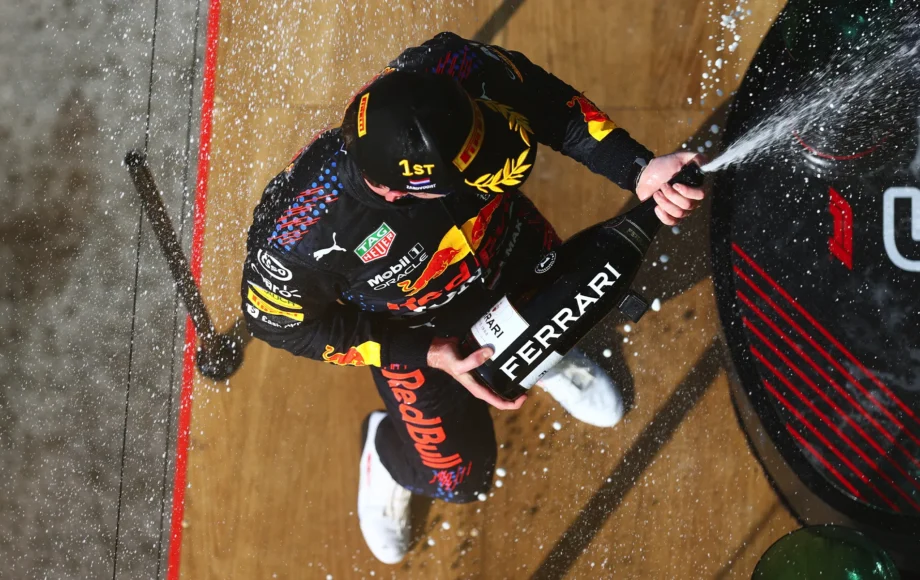Whether you are a newcomer or a seasoned fan of F1, there’s a lot to take in, from the races to Grand Prix circuits, racing regulations, and, of course, the F1 points system.
What to know
- The F1 points system currently awards points to the top 10 finishers in a race.
- Formula 1 allows drivers to earn an additional bonus point by recording the fastest lap during a Grand Prix race.
- F1 Constructors earn points from both drivers that are combined and awarded to the team as a whole.
- Drivers and teams earn points in the Sprint Race awarded for the top eight positions.
In this guide, we’ll help you to understand the points system used in Formula 1, from drivers’ points, penalty points, constructors’ points, and points awarded and won in the Sprint Races on the F1 calendar.
How do F1 points work?
Since 2010, Formula One has followed a consistent point distribution system that has undergone minor changes.
The F1 points system currently awards points to the top 10 finishers in a race. The driver who finishes first receives 25 points, then 18 for second place, 15 for third, and then a gradual reduction of points for each subsequent position until 10th place, which receives 1 point. Finishing in the top 10 is also crucial for F1 drivers to help secure points for their team.
In addition to individual driver points, F1 teams earn points based on their drivers’ performances. The top 10 finishing positions for each team’s drivers are added together, giving the team a combined total. These F1 team points are crucial in determining the Constructors’ Championship standings, with the team that has accumulated the most points in a season winning the title.
F1 Points 2010 – 2024
| Position | Points |
|---|---|
| 1st | 25 |
| 2nd | 18 |
| 3rd | 15 |
| 4th | 12 |
| 5th | 10 |
| 6th | 8 |
| 7th | 6 |
| 8th | 4 |
| 9th | 2 |
| 10th | 1 |
| Fastest Lap | 1 |
F1 Points 2025 >
| Position | Points |
|---|---|
| 1st | 25 |
| 2nd | 18 |
| 3rd | 15 |
| 4th | 12 |
| 5th | 10 |
| 6th | 8 |
| 7th | 6 |
| 8th | 4 |
| 9th | 2 |
| 10th | 1 |
As with any system in a sport, the current F1 points system has its supporters and critics. Supporters appreciate that it provides mid-field and lower-ranked drivers and teams to gain points in races where the top teams might not always finish, allowing them to gain critical financial rewards at the season’s end. However, critics argue that the system could place too much importance on finishing positions rather than taking risks for more exciting races.
History of F1’s points system
| Season(s) | 1st | 2nd | 3rd | 4th | 5th | 6th | 7th | 8th | 9th | 10th | Fastest lap | Drivers’ championship | Constructors’ championship | Sprint race |
|---|---|---|---|---|---|---|---|---|---|---|---|---|---|---|
| 1950-53 | 8 | 6 | 4 | 3 | 2 | 0 | 0 | 0 | 0 | 0 | 1 | 4 | N/A | N/A |
| 1954-57 | 8 | 6 | 4 | 3 | 2 | 0 | 0 | 0 | 0 | 0 | 1 | 5 | N/A | N/A |
| 1958 | 8 | 6 | 4 | 3 | 2 | 0 | 0 | 0 | 0 | 0 | 1 | 6 | N/A | |
| 1959 | 8 | 6 | 4 | 3 | 2 | 0 | 0 | 0 | 0 | 0 | 1 | 5 | N/A | |
| 1960 | 8 | 6 | 4 | 3 | 2 | 1 | 0 | 0 | 0 | 0 | 0 | 6 | N/A | |
| 1961 | 9 (for drivers) 8 (for constructors) | 6 | 4 | 3 | 2 | 1 | 0 | 0 | 0 | 0 | 0 | 5 | N/A | |
| 1962 | 9 | 6 | 4 | 3 | 2 | 1 | 0 | 0 | 0 | 0 | 0 | 5 | N/A | |
| 1963-65 | 9 | 6 | 4 | 3 | 2 | 1 | 0 | 0 | 0 | 0 | 0 | 6 | N/A | |
| 1966 | 9 | 6 | 4 | 3 | 2 | 1 | 0 | 0 | 0 | 0 | 0 | 5 | N/A | |
| 1967 | 9 | 6 | 4 | 3 | 2 | 1 | 0 | 0 | 0 | 0 | 0 | 9 (5 from first 6 and 4 from last 5 | N/A | |
| 1968 | 9 | 6 | 4 | 3 | 2 | 1 | 0 | 0 | 0 | 0 | 0 | 10 (5 from both first and last 6) | N/A | |
| 1969 | 9 | 6 | 4 | 3 | 2 | 1 | 0 | 0 | 0 | 0 | 0 | 9 (5 from first 6 and 4 from last 5) | N/A | |
| 1970 | 9 | 6 | 4 | 3 | 2 | 1 | 0 | 0 | 0 | 0 | 0 | 11 (6 from first 7 and 5 from last 6) | N/A | |
| 1971 | 9 | 6 | 4 | 3 | 2 | 1 | 0 | 0 | 0 | 0 | 0 | 9 (5 from first 6 and 4 from last 5) | N/A | |
| 1972 | 9 | 6 | 4 | 3 | 2 | 1 | 0 | 0 | 0 | 0 | 0 | 10 (5 from both first and last 6) | N/A | |
| 1973-74 | 9 | 6 | 4 | 3 | 2 | 1 | 0 | 0 | 0 | 0 | 0 | 13 (7 from first 8 and 6 from last 7) | N/A | |
| 1975 | 9 | 6 | 4 | 3 | 2 | 1 | 0 | 0 | 0 | 0 | 0 | 12 (6 from both first and last 7) | N/A | |
| 1976 | 9 | 6 | 4 | 3 | 2 | 1 | 0 | 0 | 0 | 0 | 0 | 14 (7 from both first and last 8) | N/A | |
| 1977 | 9 | 6 | 4 | 3 | 2 | 1 | 0 | 0 | 0 | 0 | 0 | 15 (8 from first 9 and 7 from last 8) | N/A | |
| 1978 | 9 | 6 | 4 | 3 | 2 | 1 | 0 | 0 | 0 | 0 | 0 | 14 (7 from both first and last 8) | N/A | |
| 1979 | 9 | 6 | 4 | 3 | 2 | 1 | 0 | 0 | 0 | 0 | 0 | 8 (4 from first 7 and 4 from last 8) | All | N/A |
| 1980 | 9 | 6 | 4 | 3 | 2 | 1 | 0 | 0 | 0 | 0 | 0 | 10 (5 from both first and last 7) | All | N/A |
| 1981-90 | 9 | 6 | 4 | 3 | 2 | 1 | 0 | 0 | 0 | 0 | 0 | 11 | All | N/A |
| 1991-2002 | 10 | 6 | 4 | 3 | 2 | 1 | 0 | 0 | 0 | 0 | 0 | All | All | N/A |
| 2003-09 | 10 | 8 | 6 | 5 | 4 | 3 | 2 | 1 | 0 | 0 | 0 | All | All | N/A |
| 2010-2018 | 25 | 18 | 15 | 12 | 10 | 8 | 6 | 4 | 2 | 1 | 0 | All | All | N/A |
| 2019-20 | 25 | 18 | 15 | 12 | 10 | 8 | 6 | 4 | 2 | 1 | 1 | All | All | N/A |
| 2021 | 25 | 18 | 15 | 12 | 10 | 8 | 6 | 4 | 2 | 1 | 1 | All | All | Top 3 (3-2-1) |
| 2022 – 2024 | 25 | 18 | 15 | 12 | 10 | 8 | 6 | 4 | 2 | 1 | 1 | All | All | Top 8 (8-7-6-5-4-3-2-1) |
| 2025 – Present | 25 | 18 | 15 | 121 | 10 | 8 | 6 | 4 | 2 | 1 | 0 | All | All | Top 8 (8-7-6-5-4-3-2-1) |
F1 fastest lap point
In 2019, a new rule was introduced in Formula 1, allowing drivers to earn an additional bonus point for themselves and their team by recording the fastest lap during a Grand Prix race.
To be awarded an extra point, the driver must finish in the top 10 of the race. Failure to complete the race in the top 10 will result in the driver missing out on this fastest lap point, regardless of whether they were the fastest.
Some teams and drivers use this to their advantage to deny another higher-placed driver from benefitting by pitting on the last few laps of a race to put on fresh tyres to steal that point away, even if they are outside of the top 10.
This isn’t the first time a fastest lap point has been awarded as an extra point for the fastest lap. A point was awarded in the first 1950 F1 World Championship Race, and it remained in the rule book until the end of the 1959 season.
Yet, once again the fastest lap bonus point would be removed from Formula 1 starting in the 2025 season, following a decision by the FIA’s World Motor Sport Council. During a meeting in October 2024, the council approved several updates to the Sporting and Technical regulations, including this change, while also planning adjustments for the 2026 F1 World Championship rules. This move addressed ongoing concerns about its impact on race strategy and fairness. Notably, incidents like RB driver Daniel Ricciardo setting the fastest lap in the 2024 Singapore Grand Prix to benefit parent team Red Bull and Max Verstappen in the Championship battle, taking away a point that the race leader, Lando Norris and Championship rival, had secured in the race, despite Ricciardo not being in a competitive position. That strategic move reignited debate about whether this rule was distorting the competition. Teams often exploited the rule by pitting late for fresh tyres, leading to controversies around its use
F1 constructors points system
Formula 1 features two championships for which F1 teams and drivers compete.
One championship is for the individual driver, who is crowned the F1 World Champion, while the other is for the team itself, referred to as the Constructors’ Championship.
The F1 Constructors’ Championship follows a points system similar to that used for the drivers. The key difference is that the points earned by two drivers from the same F1 team are combined and awarded to the team as a whole. For example, if Max Verstappen and Sergio Pérez drive for Red Bull Racing, the points they earn are tallied together and credited to the Red Bull team.
The stakes for this championship are incredibly high, as a team’s final position on the leaderboard directly impacts the amount of money Formula 1 awards them and the amount of money they have at their disposal for the following year.
F1 sprint race points
In the current format, F1 drivers who finish within the top eight positions in the Sprint event will earn championship points, a considerable increase from the 2022 season when points were solely allocated to the top three finishers. As a result, this has created more fierce and spirited races among drivers.
At the end of the season, these points can make all the difference in determining the champion. Every point counts, and the Sprint Race allows drivers to gain an edge over their rivals.
So, while the Sprint Race may be shorter and more intense than a regular race, it still carries significant weight in terms of championship points and awards.
| Position | Points |
|---|---|
| 1st | 8 |
| 2nd | 7 |
| 3rd | 6 |
| 4th | 5 |
| 5th | 4 |
| 6th | 3 |
| 7th | 2 |
| 9th | 1 |
F1 penalty points
How many penalty points are you allowed in F1?
Formula 1 regulations prohibit drivers from accumulating more than 12 penalty points on their licenses within 12 months. Should drivers pass this threshold, they will be disqualified from participating in the next race. Any penalty points issued beyond 12 months will automatically be erased from the driver’s record.
How does a driver receive F1 penalty points?
Whenever drivers are found to have violated any rules, regulations, or laws, they will be handed an F1 penalty point as a punitive measure. The gravity of the offence affects how many penalty points are given. A minor infringement frequently incurs only one penalty point. It could be a driver leaving the track and gaining an advantage. A significant infraction, like causing a crash, could attract more penalty points.
F1 half points
Formula 1 unveiled a new points system in 2023, designed to avoid a repeat of the controversy surrounding the 2021 Belgian Grand Prix. During that event, F1 drivers were only awarded half of the regular championship points after being forced to spend three laps behind the safety car without any racing taking place. The new system prevents such a scenario from happening again and ensures drivers are awarded the full amount of points.
Starting in 2023, drivers must complete at least two laps before being eligible for any points. Additionally, a new four-tiered points system will be implemented, with the points awarded on a sliding scale based on the percentage of the scheduled race distance completed. Drivers who complete at least 75% of the race distance will be eligible for the full amount of points available.
This new point system is designed so that ‘half points’ are no longer possible.
| Position | At least 2 laps Less than 25% race distance | At least 25% Less than 50% race distance | At least 50% Less than 75% race distance | More than 75% race distance |
|---|---|---|---|---|
| 1 | 6pts | 13pts | 19pts | 25pts |
| 2 | 4pts | 10pts | 14pts | 18pts |
| 3 | 3pts | 8pts | 12pts | 15pts |
| 4 | 2pts | 6pts | 9pts | 12pts |
| 5 | 1pt | 5pts | 8pts | 10pts |
| 6 | 4pts | 6pts | 8pts | |
| 7 | 3pts | 5pts | 6pts | |
| 8 | 2pts | 3pts | 4pts | |
| 9 | 1pt | 2pts | 2pts | |
| 10 | 1pt | 1pt |
F1 tied points
In the event of a tie, the teams and drivers with the most wins in the season are ranked higher.
In the event of a tie in the championship standings, the first critera used to determine the ranking is the number of wins. The team or driver with the most wins throughout the season is ranked higher.
If the number of wins is equal, the second tie-breaker is the number of second-place finishes. This is followed by the number of third-place finishes until a clear distinction can be made.
In the rare scenario where everything is still equal after considering all the finishing positions, the FIA has the authority to make a final decision based on factors such as overall performance, sportsmanship, and fair play.
Ties in the F1 championship standings are rare, but when they occur, the tie-breaker rules ensure that a deserving champion emerges.
F1 points transfer
Formula 1 drivers score points by finishing in the top 10. If a driver opts to change teams during a season, they retain their individual driver points, and their previous team keeps the points scored while driving for them.
The concept of points transfer adds an exciting dynamic to the championship standings. It allows drivers to continue building on their point tally regardless of which team they represent. This is particularly significant when considering the impact of mid-season driver transfers, which occasionally happen in Formula 1.
The points transfer rule means that each driver’s individual performance is recognised and accounted for throughout the season.
More F1 points
For the latest F1 standings, check out the most recent race results or look back at noteworthy races from drivers and constructors with their all-time F1 records.
Seen in:










